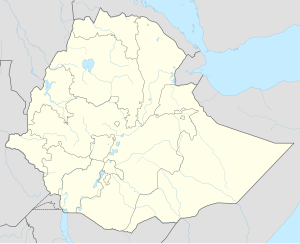Debre Markos
Debre Markos
ደብረ ማርቆስ | |
|---|---|
 A street in Debre Markos | |
| Coordinates: 10°20′N 37°43′E / 10.333°N 37.717°E | |
| Country | Ethiopia |
| Region | Amhara Region |
| Zone | Misrak Gojjam Zone |
| Elevation | 2,446 m (8,025 ft) |
| Population (2012) | |
| • Total | 262,497 |
| Time zone | UTC+3 (EAT) |
| Area code | +251 |
Debre Markos (Template:Lang-am, also called Menkorer), former capital of Gojjam Province, is a city and woreda in northwest Ethiopia. Located in the Misrak Gojjam Zone of the Amhara Administrative Region, it has a latitude and longitude of 10°20′N 37°43′E / 10.333°N 37.717°E, and an elevation of 2,446 meters.
History
Origins
The city is named Debre Markos after its principal church, which was constructed in 1869 and dedicated to St. Markos.[1] Debre Markos was the capital of Tekle Haymanot, Nigus of Gojjam during his reign and as a result, Pankhurst notes, the population of Debre Markos "fluctuated greatly with the presence of absence of the army" of the Negus. He states that when the Nigus resided in the town, it had between 20,000 and 40,000 inhabitants; in his absence, between 5,000 and 6,000. The explorer Pellegrino Matteucci (b. 1850) arrived at what was at that time named Monkorer on 3 June 1879, explored the neighboring area, then departed 20 June for Adwa and Massawa.
20th Century
The palace of Nigus Tekle Haimanot was remodeled in 1926 by his son Ras Hailu Tekle Haymanot, in the style of European buildings after his tour of Europe in the party of Ras Tefari. In 1935, the town had postal, telegraph, and telephone service.[1]
The Italians arrived in Debre Markos 20 May 1936. Through an interpreter, Achille Starace, who had arrived by plane, told the surprised local inhabitants that he had come to free them from their oppressors to their thorough bemusement. Debre Markos was later isolated and practically besieged by a revolt in 1938. General Ugo Cavallero, with sixty thousand men and supported by airplanes and tanks, had crushed the revolt by the end of May.[1] A major Italian fortification was located in the city during the existence of Italian East Africa, and captured by the British Gideon Force and Ethiopian Arbegnoch (or Resistance Fighters) 3 April 1941 during the East African Campaign.
In 1957, Nigus Tekle Haimanot School in Debre Markos was one of 9 provincial secondary schools in Ethiopia. The next year, the town was one of 27 places in Ethiopia ranked as a First Class Township. In 1960 a branch of the Ethiopian Electric Light and Power Authority had started operation in Debre Markos.[1]
Education
Debre Markos has Public Research University, Teachers College, and Private Colleges.
Climate
As typical of the elevated portions of Ethiopia the climate is subtropical highland (Köppen: Cwb), despite the proximity to the Equator. March is the warmest month with 25.1 °C and July the coldest with 18.9 °C in the average monthly temperature. The fall of the rain is considerably irregular going from 12 mm in January to 309 mm in July, being therefore still the main differentiator of the seasons of the year.[2]
Demographics
Based on the 2007 national census conducted by the Central Statistical Agency of Ethiopia (CSA), in 2012 Debre Markos has had an estimated population of 262,497, of whom 129,921 were men and 132,576 women. The majority of the residents, 97.03%, practiced Ethiopian Orthodox Christianity, while 1.7% of the population said they were Muslim and, 1.1% were Protestants, respectively. [3]
The 1994 national census reported a total population for Debre Markos of 49,297 in 9,617 households, of whom 22,745 were men and 26,552 were women. The largest ethnic group of the town was reported to be the Amhara (97.12%) while the rest including Tigrayan, Oromo (0.67%) and others comprising less than 3% of the population. The majority of the inhabitants practiced Ethiopian Orthodox Christianity, with 97.25% reporting that as their religion, while 1.88% were Muslim, and 0.81% were Protestant.[4]
Transportation
The city has three highways and one airport, Debre Markos Airport.
Economy
Construction on Africa's first electric bus manufacturing factory began on 43 hectares of land in Debre Markos in January, 2007 by Rus Afro Trolleybus, a joint Russian-Ethiopian partnership. CEO and major shareholder Getachew Eshetu has predicted that the factory will have the capacity to manufacture 500 trolley buses per year, and employ 5,000 people. However still it is not began electric bus manufacturing up to 2020.
attractions of Debre Markos the water tower of Africa's, Mount chokea. The mountain range is located in the East African Horn of Ethiopia, around 60 km north of Gojam Debre Markos, and at 4100 asl. Home of Wildlife, which are stimulating memory, death cells, work and stress
there are also the monuments, poetry, books and songwriters spiritual and historical traditional school Dima Giorgis Orthodox church , the Emperor Asrat, the mysterious religion, the palace, and so forth.
Notes
- ^ a b c d "Local History in Ethiopia" Archived 2008-02-27 at the Wayback Machine The Nordic Africa Institute website (accessed 6 December 2007)
- ^ "Debre Markos climate: Average Temperature, weather by month, Debre Markos weather averages - Climate-Data.org". en.climate-data.org. Retrieved 2019-02-17.
- ^ Census 2007 Tables: Amhara Region Archived November 14, 2010, at the Wayback Machine, Tables 2.1, 2.4, 2.5, 3.1, 3.2 and 3.4.
- ^ 1994 Population and Housing Census of Ethiopia: Results for Amhara Region, Vol. 1, part 1 Archived November 15, 2010, at the Wayback Machine, Tables 2.1, 2.7, 2.10, 2.17, Annex II.2 (accessed 9 April 2009)


